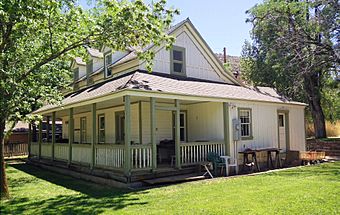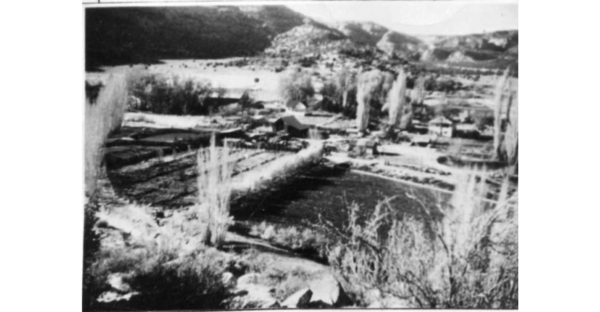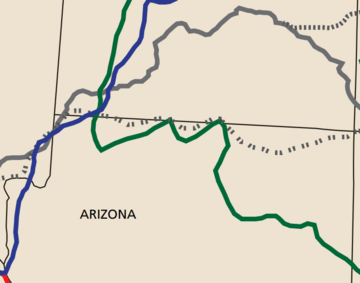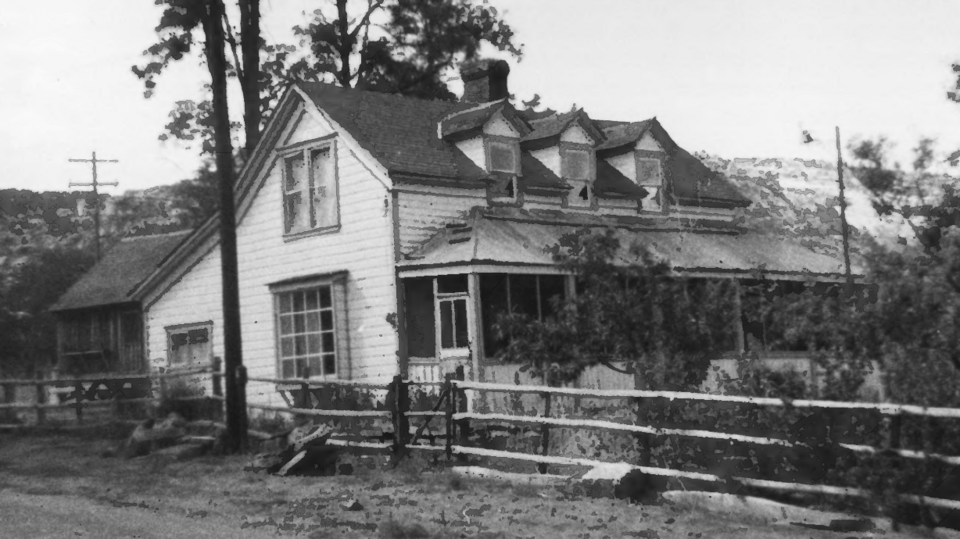Big House (Moccasin, Arizona) facts for kids
Quick facts for kids |
|
|
Big House
|
|

The Big House in 2016
|
|
| Location | W. Center St., Moccasin, Arizona |
|---|---|
| Area | 1.3 acres (0.53 ha) |
| Built | 1875 |
| Built by | Dellie Webb, Heber Ayers |
| Architect | Dellie Webb, Heber Ayers |
| Architectural style | Vernacular Saltbox |
| NRHP reference No. | 83003497 |
| Added to NRHP | October 20, 1983 |
The Big House in Moccasin, Arizona is a historic home built around 1875. It was created by skilled builders who were part of a group called the United Order from Orderville, Utah. This house was one of the first large homes in the quiet northern Arizona area of Moccasin. For many years, it was a busy place for the community and for religious gatherings. Many people traveling on the old Mormon Honeymoon Trail even stayed here.
Contents
A Look Back: The Big House's History
In the late 1800s, leaders of the LDS Church helped people settle in southern Utah and northern Arizona. One of these settlements was Pipe Spring, started in 1870. Around the same time, the community of Moccasin began at Moccasin Spring, just a few miles north of Pipe Spring. Both places were on the Mormon Honeymoon Trail. This trail connected towns in the Little Colorado River area to St. George, Utah. St. George was important because it had the first LDS Temple built in Utah.
Who Built the Big House?
The Big House was built around 1875 by two carpenters, Dellie Webb and Heber Ayers. They were part of the Orderville United Order. People called it the "Big House" because most other homes in Moccasin at that time were small, one-room cabins.
The house was built for John Covington and his family. They were chosen to take care of the Moccasin property for the Orderville United Order. In 1883, Christopher B. Heaton took over from Covington as the caretaker of the Big House and other properties.
The Big House and Native Americans
Christopher Heaton was also given the job of being a missionary to the Native American people in the area. The Kaibab Band of Southern Paiute Indians had lived on and used the Arizona Strip area for a very long time, since about 1150 A.D. This area included Pipe Spring, Moccasin Spring, and Sand Spring. Today, the Big House and Moccasin community are on a small piece of land that is not part of the larger Kaibab Indian Reservation.
Starting in the 1880s, the Orderville United Order slowly sold or gave its properties to its members. The Big House and other Moccasin properties went to the Heaton family. After Christopher Heaton moved away, his brothers Jonathan, Alvin, Fred, and Will Heaton took ownership. By 1894, Jonathan Heaton became the sole owner of the Big House. Jonathan and his wife, Lucy Heaton, raised their eleven children in this historic home.
Life at Moccasin Ranch
Emma Carroll Seegmiller, Lucy Heaton's sister, wrote about what life was like at the Moccasin Ranch in the late 1800s:

She said there were lots of fruits like peaches, grapes, and melons. They also grew sugar cane to make molasses, which was their main way to sweeten food. In the fall, kids helped pick potatoes and top beets and carrots. They would sit around piles of vegetables, singing and talking while they worked. Farming and raising animals were very successful at Moccasin Ranch.

The path along the Vermilion Cliffs, passing by Pipe Spring and Moccasin Spring, was used by Native Americans for a long time. It later became part of the Armijo Route of the Old Spanish Trail. This trail connected Santa Fe and Los Angeles after Antonio Armijo explored it in 1829-1830. After Mormon settlers arrived, this path became known as the Honeymoon Trail. It linked Mormon towns in southern Utah and northern Arizona to St. George.

A Busy Stop on the Honeymoon Trail
The Big House was a very important stop on the Honeymoon Trail. Many guests and visitors stayed there overnight. One month, the Heaton family counted serving 110 meals to guests and feeding 35 horses! Guests included important people like governors, church leaders, and business people. Cowboys, herders, and Native Americans also stayed there.
The Big House was also used for school classes, community meetings, and religious services for many years. This continued until a community school was built in Moccasin in 1904.
Why is the Big House Important Today?
Listed on the National Register
The Big House was added to the National Register of Historic Places in 1983. This means it is recognized as an important historical site. The listing included two main buildings: the Big House itself and a Granary built around 1880, which is located nearby.




